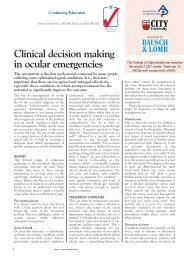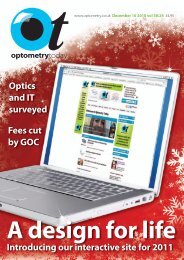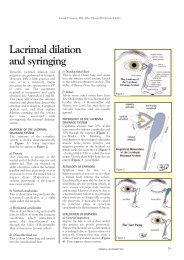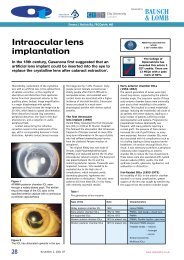Toric contact lenses fitting - Optometry Today
Toric contact lenses fitting - Optometry Today
Toric contact lenses fitting - Optometry Today
Create successful ePaper yourself
Turn your PDF publications into a flip-book with our unique Google optimized e-Paper software.
<strong>Toric</strong> <strong>contact</strong> <strong>lenses</strong> <strong>fitting</strong><br />
The changing dynamics of soft CL technology<br />
Susan Resnick OD, FAAO<br />
The past two decades have brought remarkable advances and innovation in<br />
soft <strong>contact</strong> lens technology. The vastly superior hydrogel <strong>lenses</strong> that we<br />
prescribe today came about as a result of gradual yet significant<br />
improvements in lens design, materials and manufacturing capabilities.<br />
Eyecare practitioners now enjoy an everincreasing<br />
array of <strong>contact</strong> lens options with<br />
which to satisfy patients’ needs and<br />
expectations for comfort, convenience and<br />
visual satisfaction. Undoubtedly, however,<br />
most of us in the trenches recognise that<br />
there is still room for improvement in certain<br />
aspects of soft lens design and fabrication.<br />
One such area is the toric hydrogel lens<br />
category.<br />
We have certainly come a long way from<br />
the time when <strong>fitting</strong> soft toric <strong>contact</strong><br />
<strong>lenses</strong> was largely relegated to the ‘<strong>contact</strong><br />
lens specialist’. Throughout the last decade<br />
in particular, with the advent of improved<br />
lathing techniques and the development<br />
and introduction of moulded <strong>contact</strong> <strong>lenses</strong>,<br />
we have witnessed a quantum leap in lens<br />
quality and reproducibility. The subsequent<br />
availability of toric designs in a planned<br />
replacement modality, along with significant<br />
expansions in parameter ranges, have<br />
further served to ‘mainstream’ soft<br />
astigmatic <strong>contact</strong> lens <strong>fitting</strong>. Yet concerns<br />
related to patient and practitioner satisfaction<br />
have continued to plague this niche<br />
market.<br />
If we compare our clinical experiences<br />
with spherical lens wearers to those with<br />
our astigmatic patients, it is apparent that<br />
the expectations of the latter group are still<br />
not fully met. Our toric lens patients invariably<br />
do not attain the levels of overall vision<br />
quality that spherical <strong>lenses</strong> provide. These<br />
patients often report inferior visual acuity<br />
compared to what they achieve with their<br />
spectacles. While a consistent level of mildly<br />
reduced visual quality may be a compromise,<br />
some patients are willing to accept<br />
this. Problems related to rotational instability<br />
and variability of vision remain obstacles<br />
to satisfying the visual needs of many.<br />
Likewise, patient satisfaction with the<br />
physical comfort of soft toric lens designs<br />
About the author<br />
Dr Susan Resnick is a principal in a<br />
specialty <strong>contact</strong> lens practice in New<br />
York City and Roslyn, NY. She serves<br />
on new product advisory panels and<br />
as a media liaison for Vistakon. She<br />
has no financial interest in the<br />
product mentioned in this article<br />
has historically lagged behind that of spherical<br />
lens wearers. While newer, thinner<br />
<strong>lenses</strong> incorporating enhanced edge profiles<br />
greatly diminish overall lens awareness as<br />
compared to previous designs, a considerable<br />
percentage of patients still do not<br />
achieve the level of comfort they desire. This<br />
is most apparent in those who require an<br />
astigmatic lens on one eye only, or those<br />
who are marginally tolerant or are more<br />
highly sensitive individuals.<br />
Practitioner satisfaction is inextricably<br />
linked to patient satisfaction, for this is how<br />
we gauge our success. We desire and<br />
expect rapid, predictable and stable lens<br />
positioning. These are the requisite<br />
functional attributes of lens design that will<br />
provide our patients with the clarity and<br />
consistency of vision they require and<br />
deserve. We also strive to offer our<br />
astigmatic patients parity in the same level<br />
of comfort afforded to our spherical lenswearing<br />
patients. More than 40% of the<br />
vision corrected population requires<br />
astigmatic corrections for levels of 0.75D or<br />
more. Estimates place practitioner satisfaction<br />
levels with current technology at a low<br />
14% 1 . Thus, it is important that manufacturers<br />
continue to devote energy and<br />
resources to research and development in<br />
this vital area of <strong>contact</strong> lens care.<br />
Thirty years and few innovations<br />
Two principal methods of toric lens design<br />
have been used throughout the past 30<br />
years in an attempt to achieve the goal of<br />
lens stabilisation – prism ballast and dual<br />
thin zones. These conventional soft toric<br />
designs, while conceptually sound, are<br />
limited by conventional fabrication methods<br />
– lathing or grinding of lenticulated or offaxis<br />
zones. When manufacturers try to fit<br />
their current lens designs within the<br />
framework of their current manufacturing<br />
capabilities, the number of degrees of<br />
freedom available to the lens designer is<br />
reduced. The obvious main result, as seen<br />
over the past few years, is a series of<br />
products showing only incremental<br />
improvements over their predecessors<br />
within the same family of designs.<br />
In a clinical setting, practitioners witness<br />
the varying degrees of influence that lid<br />
configuration (such as lid angles and lid<br />
tightness) and ocular surface anatomy (such<br />
CLINICAL<br />
Astigmatic <strong>contact</strong> lens <strong>fitting</strong><br />
Zone of thickness<br />
➛<br />
Figure 1<br />
The Accelerated Stabilisation Design (ASD)<br />
of ACUVUE ® ADVANCE ® Brand Contact<br />
Lenses for Astigmatism provides a new<br />
level of stabilisation (for illustration purposes only)<br />
as conjunctival elevations) have on the<br />
effectiveness and feasibility of each of these<br />
conventional designs. Other factors shown<br />
to affect the orientation position of toric<br />
soft <strong>lenses</strong> include the degree of myopia<br />
and palpebral aperture size 2 .<br />
While we may observe general trends<br />
with a given design or brand, we have not<br />
been able to accurately predict soft lens<br />
orientation with any consistency based<br />
upon anatomical factors. In an attempt to<br />
improve consistency and rapidity in lens<br />
orientation, refinements have been made<br />
along the way in the form of periballasting<br />
and eccentric lenticulation. However, no<br />
new advancements in design have been<br />
made.<br />
Improvements in toric lens design<br />
Prism ballast and conventional dual thin<br />
zones designs are based on the same<br />
‘watermelon seed’ principle, which teaches<br />
that a wedge will orient itself in such a way<br />
as to decrease the pressure on its thick side.<br />
While this design concept is sound and has<br />
been shown to be effective in orienting<br />
<strong>lenses</strong>, it has not been optimised to take<br />
into account the fact that the principle<br />
applies regardless of the lens orientation<br />
because the lid forces repeat themselves<br />
blink after blink. As a result, the same lid<br />
forces that tend to orient a misoriented lens<br />
will also tend to dislodge a properly aligned<br />
lens. The effect of these forces is to reduce<br />
lens stability, which leads to unstable vision<br />
over time.<br />
Improved understanding of eye dynamics<br />
and the application of advanced manufacturing<br />
techniques has provided the<br />
engineering synergism responsible for the<br />
next generation of soft toric <strong>lenses</strong>. One<br />
such design that uses the forces of the blink<br />
is the Accelerated Stabilisation Design (ASD)<br />
of ACUVUE ® ADVANCE ® Brand Contact<br />
Lenses for Astigmatism. Much like the ‘on<br />
demand’ four-wheel drive feature now<br />
available in many motor vehicles, this design<br />
features multiple ‘active zones’ that permit<br />
the lid to interact with the lens in a positive<br />
39 | May 5 | 2006 OT
CLINICAL<br />
Astigmatic <strong>contact</strong> lens <strong>fitting</strong><br />
way, but only when required (Figure 1). The<br />
lens is designed in such a way that the<br />
watermelon seed principle is maximised<br />
when the lens is misoriented, and<br />
minimised when the lens is correctly<br />
aligned. The result is a lens that rotates<br />
quickly to its desired position and remains<br />
stable when properly aligned.<br />
Revolutionary advancements<br />
Factors influencing corneal physiology and,<br />
ultimately, patient comfort in toric lens<br />
designs do not differ from those we<br />
encounter with spherical <strong>lenses</strong>, but they<br />
are often more clinically significant. Chronic<br />
hypoxia of the peripheral cornea (often<br />
inferiorly in ballasted designs and nasotemporally<br />
in traditional thin zone designs) may<br />
be evident in the form of unacceptable<br />
levels of localised peripheral or circumlimbal<br />
neovascularisation 3 . Symptoms may include<br />
reduced wearing time and red eyes. Lens<br />
surface drying, whether attributable to<br />
reduced tear volume or unstable tear film,<br />
have been associated with blurry and<br />
changeable vision 4 . This may further<br />
diminish the marginal visual quality or<br />
inconsistency in acuity that our current toric<br />
lens wearers suffer. Post-blink movement<br />
and lens tightness have been correlated<br />
with lens orientation 2 .<br />
Fortunately, silicone hydrogel technology<br />
has eliminated or substantially reduced<br />
many of these adverse and undesirable<br />
hypoxia-related issues. Many patients report<br />
fewer dry eye symptoms, perhaps because<br />
of the lower water content of these materials<br />
or from reduced surface dehydration 5,6 .<br />
Having experienced the clinical advantages<br />
of these materials as spherical lens designs<br />
over the past few years, we have been<br />
looking forward to being able to offer these<br />
same improvements to our toric lens<br />
patients.<br />
The availability of a toric lens made in a<br />
material using Hydraclear technology may<br />
be a compelling enough reason to embrace<br />
the new toric product by Johnson &<br />
Johnson Vision Care – but I believe that<br />
ACUVUE ADVANCE Brand Contact Lenses<br />
for Astigmatism truly raises the bar for toric<br />
lens performance. Many patients are<br />
impressed with the lens’ extraordinary<br />
comfort upon application. In one large<br />
scale, masked independent clinical study,<br />
92% of <strong>lenses</strong> oriented within 10˚ of the<br />
zero position at settling time (Figure 2), and<br />
96% of <strong>lenses</strong> remained within 5˚ of the<br />
settled position after three minutes (Figure<br />
3) 7 . In fact, the lens consistently orients<br />
within a minute or two of application and<br />
exhibits minimal rotation and virtually no<br />
variability of axis position. The same study<br />
found that 87% of <strong>lenses</strong> oriented within<br />
one minute at 5˚ (Figure 2), and 85% of<br />
<strong>lenses</strong> remained within five degrees of<br />
settled position within one minute (Figure<br />
3). No extended settling period, multiple<br />
rechecks or multiple diagnostic <strong>lenses</strong> were<br />
required, so chair time is therefore greatly<br />
100<br />
80<br />
60<br />
40<br />
20<br />
0<br />
87<br />
66<br />
47<br />
One minute<br />
87<br />
reduced, and patients report excellent endof-day<br />
comfort with less redness 7 .<br />
So begins an exciting era in the evolution<br />
of toric lens technology. ACUVUE<br />
ADVANCE Brand Contact Lenses for<br />
Astigmatism will help us to turn the page<br />
on accepting vision that is only good<br />
enough, on our reluctance to fit toric <strong>lenses</strong><br />
because of the time and effort involved, and<br />
on the frustrations of unsatisfactory <strong>fitting</strong><br />
outcomes. New toric lens wearers will now<br />
have a better chance than ever at success<br />
with the first <strong>lenses</strong> they try.<br />
Current wearers will enjoy more stable<br />
vision and better comfort in environments<br />
or during activities that previously may have<br />
been problematic. No longer should we feel<br />
compelled to avoid <strong>fitting</strong> our low-cylinder<br />
patients because we believe that it’s not<br />
worth it. This new lens should rekindle our<br />
enthusiasm and refuel our confidence in<br />
delivering results that satisfy the highest<br />
expectations of our toric patients and that,<br />
in turn, boost our professional satisfaction.<br />
71<br />
59<br />
Three minutes<br />
References<br />
92<br />
76<br />
66<br />
Traditional setting<br />
Figure 2<br />
Ninety-two percent of <strong>lenses</strong> oriented within 10˚ at settling time, and 87%<br />
of <strong>lenses</strong> oriented within 5˚ within one minute<br />
100<br />
80<br />
60<br />
40<br />
20<br />
ACUVUE ® ADVANCE for Astigmatism (n=366 eyes/<strong>lenses</strong>)<br />
Traditional Prism Ballast Benchmark (n=352 eyes/<strong>lenses</strong>)<br />
Traditional Dual Thin Zone benchmark (n=152 eyes/<strong>lenses</strong>)<br />
85<br />
76<br />
65<br />
Orientation within 5˚<br />
Rotational stability within 5˚<br />
96<br />
0<br />
One minute<br />
Three minutes<br />
Figure 3<br />
Ninety-six percent of <strong>lenses</strong> remained within 5˚ after three minutes, and 85%<br />
remained within 5˚ within one minute<br />
86<br />
76<br />
1. Data on file, Vistakon, a division of<br />
Johnson & Johnson.<br />
2. Young G, Hunt C and Covey M (2002)<br />
Clinical factors influencing toric soft<br />
<strong>contact</strong> lens fit. Optom. Vis. Sci. 79 (8):<br />
11-19.<br />
3. Bergenske P (2005) Prescribing soft toric<br />
<strong>contact</strong> <strong>lenses</strong>. Contact Lens Spectrum<br />
20 (2): 34-9.<br />
4. Begley CG, Caffery B, Nichols KK and<br />
Chalmers R (2000) Responses of<br />
<strong>contact</strong> lens wearers to a dry eye survey.<br />
Optom. Vis. Sci. 77 (1): 40-6.<br />
5. Snyder C (2004) A primer on <strong>contact</strong><br />
lens materials. Contact Lens Spectrum<br />
19 (2): 34-9.<br />
6. Jones L (2002) Modern <strong>contact</strong> lens<br />
materials: a clinical update.<br />
Contact Lens Spectrum 17 (9): 24-35.<br />
7. Data on file, Vistakon, a division of<br />
Johnson & Johnson<br />
Acknowledgement<br />
Originally published by Review of Cornea & Contact Lenses, May 5©2005 Jobson Publishing.<br />
40 | May 5 | 2006 OT

















